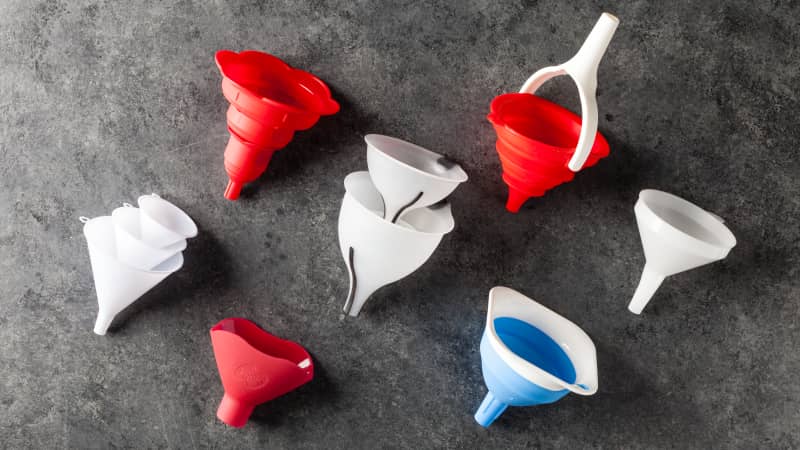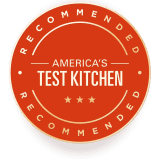Chili Powder
Taste Test
One simple tool can prevent so many messes.
Published Sept. 1, 2018.

When you need to transfer a lot of food or liquid from one container to another, you reach for a funnel—or else you're likely to slosh oil or spill peppercorns all over your counter. You pour food or liquid into the funnel's wider opening, which then narrows into a spout, directing the goods into the intended receptacle. This small tool has a major payoff: It eliminates spills and minimizes waste—but only if you have a good funnel.
Since we last tested, our winner, the Progressive Collapsible Funnel, has been discontinued, and new models are now on the market. We selected seven funnels priced from $4.41 to $14.19, using each one to transfer foods and liquids with different textures into containers of varying sizes, including peppercorns into a pepper mill, herbs and spices from bulk containers to spice jars, thick barbecue sauce from a saucepan to a squeeze bottle, and olive oil from a gallon-size jug to a smaller bottle. We also tested how easy the funnels were to store, how durable they were, and how well they suited a range of testers. Three models came in sets, so we tested any funnel in each set that was 1 cup or larger; we've found in previous testings that funnels with a smaller capacity are less versatile, as thicker liquids and peppercorns easily overwhelm them.
Our testing proved that two characteristics are essential to a great funnel: stability (the degree to which a funnel wobbles during use) and flow (how easily liquids and foods move through the funnel).
Funnels with longer spouts, at least 1½ inches long, were more stable. These spouts served as an anchor in vessels to prevent wobbling, making them feel secure enough to use hands-free. Funnels with shorter spouts felt unsteady, like they might tip over at any second, and they were harder to use because we always had to stabilize them with one hand.
A funnel's chief purpose, however, is to promote flow and keep everything moving with no backups or spills. The key to this was the size of the spout's opening. The narrowest acceptable opening was ⅜ inch in diameter; any smaller and we had to whack, vigorously shake, or for one silicone model, milk it like a cow to get things moving. Still, oversize openings were also a problem. Two models had nozzles that measured more than 1 inch wide; this was too large to fit neatly inside all the containers we tested, and we often had to perch these models atop containers or place them outside the containers' rims. This led to more messes.
The shape of the spout's opening mattered, too. One funnel's nozzle wasn't just oversize—it was also slanted. When we perche...

The mission of America’s Test Kitchen Reviews is to find the best equipment and ingredients for the home cook through rigorous, hands-on testing. We stand behind our winners so much that we even put our seal of approval on them.

This is a members' feature.